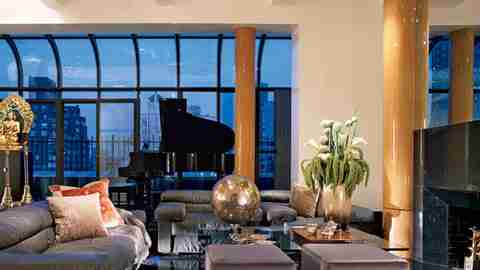Meditation in New York
View Slideshow

A designer who maintains a relationship with a client over 25 years is likely to see his client's life, and home, undergo a number of changes. When Juan Montoya and Alice Kandell first met in the early 1980s, Montoya was a beginning designer whose bold use of unexpected materials instantly captured Kandell's imagination. Kandell, in turn, was a young mother of two sons who wanted her Upper East Side apartment to have a stylish but family-friendly appeal. "I told Juan I needed a football field," Kandell recalls with a laugh. "And somehow he even made that chic."
With her sons grown and long on their own, Kandell recently invited Montoya back to her apartment and asked him to reconceive it for her present needs. In the intervening decades Kandell had received a doctorate in early child development and established, then moved on from, a career as a therapist. She had studied photography and published half a dozen books, the earliest of which activated a now passionate interest in Tibetan art. Her work as a philanthropist and as chair of the International Opera Alliance meant that she often hosted large events. "It was time," she says forthrightly, "to get rid of the football field and make a home that reflects who I am and what I do—today."
Montoya, for his part, was delighted to return to the apartment, which is something of a curiosity. It consists of parts of two floors in a Rosario Candela building that show only traces of Candela's trademark elegant prewar detailing. In addition, they are not configured like most duplexes: Upstairs there is the penthouse, with a large living room, an adjoining library and kitchen and a spacious, contiguous roof garden; the space downstairs is not directly under the penthouse but in a different line altogether. It is accessed by a glazed staircase that echoes a large greenhouse window in the living room.
The eccentricities of the apartment provided Montoya, who was assisted by project director Shaler Ladd III, with just the kind of prodding that can bring out calibrations of special flair in an experienced designer. In the living room, for instance, where the greenhouse window enclosed a raised platform anchored by a single supporting column, Montoya simply added a second, nonsupporting column, clad both in honey-stained anegre and centered the piano between them. "He created an instant stage," Kandell says, "and now we use it all the time."
Other pairs of similarly clad columns frame the fireplace and the entrance from the foyer and speak to both Candela's traditional beam ceiling and more contemporary features, such as the abundant glazing, the crisp fireplace surround and the gleaming black-granite floor, which Montoya chose because "it makes the room feel large, sharp and modern."
Another element involved taking a pedestrian hallway and transforming it into a dramatic portal that now invites a visitor into the library. On one side of the hall, Montoya fitted out a swank new granite-and-mirror bath; on the other, he designed a niche to house one of Kandell's many gilt Buddhas. Then, in the library beyond, where the granite floor continues and the fabrics, as in the living room, are carefully neutral, a 19th-century Tibetan thangka sends out a flame of color and pattern, a jolt of visual energy that animates the environment.
This juxtaposition of the streamlined and the neutral with the colorful and the complex characterizes Montoya's work throughout the apartment, though it is most dramatically demonstrated downstairs. Here Montoya had a specific consideration. For decades now Kandell has been building a very specialized, very beautiful collection of Tibetan artifacts in wood, fabric and gilt bronze. She describes the enterprise as "a kind of addiction—when I see a good piece, I have to have it." What is a good piece? For Kandell it must have an inner beauty that speaks to her. Size is irrelevant. She likes objects that are whole: Buddhas with their bases; thangkas that remain mounted on their fabric surrounds.
She collects only antiques that were brought out of Tibet before the Chinese took over the country. She is also very particular about the way the objects are regarded and displayed. "Although they are often—almost always—very artistic," Kandell explains, "they were not made as art. They were made as works of devotion, and I wanted to display them as they would have been displayed in a Tibetan shrine."
Montoya rose comfortably to the challenge of helping Kandell find a way to protect and show her collection. He created an intimate, crisp white vestibule. One direction leads to Kandell's similarly crisp bedroom retreat; the other leads to the sons' former bedrooms, now reconfigured into a two-part cocoon. The first room houses the study; the second the collection itself. The walls in both are painted a deep red. Stepping into them is like stepping into Aladdin's cave or a cabinet of curiosities enlarged to walk-in scale. The rugs, the cushions, the painted furniture, the thangkas, the Buddhas, the prayer books, all exquisitely lit and meticulously arranged (with assistance from Kandell's longtime curator, Phillip Rudko), are a magically enticing expression of one woman's abiding interest in a culture to which, even though she is not a practicing Buddhist, she feels "profoundly connected."
For Montoya, working with Kandell on this project was a splendid opportunity. "Many people collect treasures," he says, "and they don't know what to do with them. Not Alice. In this collection you feel her excitement for a vast and fascinating world. She is a little bit obsessed and a lot in love."